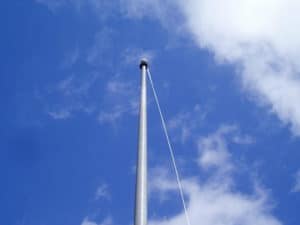Flagpoles look simple when you glance at them, but the process of buying one can be hectic if you don’t have proper guidance.
Follow this guide if you are looking for a flagpole to install on your manufactured home porch.
How Many Types of Residential Flagpoles Are Out There For Mobile Homes?
There are two:
1. In-Ground Flagpoles
A ground installed residential flagpole can range between 8′ to 24′ in height. They are normally sold in four distinct styles and sizes
- 8′ and 10′ pole (1 piece, about 1.5″ diameter)
- 20′ pole (5 pieces, about 2″ diameter, often 18′ when installed)
- 24′ pole (1 piece, about 2.375″ diameter, about 24′ when installed)
- 24″ sectional pole (about 3 pieces, about 2.375″ diameter, 24′ when installed)
2. Wall Mount Flagpoles
These are wall-mounted residential flagpoles great for the front part of a building, especially if your home is located in a suburb or urban area where land is limited.
They are normally sold in two different wall mounted kits. Here they are:
- 6′ Spinning Pole Kits (2 pieces, about 1″ diameter. Normally comes with an adjustable bracket)
- 8′ Pole Kits (2 pieces, about 1″ diameter. Normally comes with a bracket)
Wait, Do I Even Need a Flagpole?
Yes, you need one.
There are numerous reasons why you may want to get one.
- What if your visitors want to know the depth of your allegiance to your country?
- Passersby and onlookers too would be more interested in seeing how patriotic you are.
- Also, flags can be different. You can’t be very sure you’ll only be flying the national or state flag.
- Maybe you want to put your sexuality on display, or something like that.
- You are free to fly virtually any flag in your home in most parts of the United States. Whichever flag you identify with, you will need a flagpole to hoist it.
What Are the Things That Should Be Factored When Choosing a Residential Flagpole?
Well, there are a few important ones. Choosing a residential flagpole isn’t as easy as it may seem.
Needless to mention, the market is literally flooded with all sorts of flagpoles made from many different materials. It can be a real challenge narrowing down to a specific option in the sea of different designs of flagpoles.
Bear in mind these factors:
1. Size and Height
First off, determine the location where any of the two major types of residential flagpoles would be fit without looking out of place.
Height
Now, speaking of size and height, it only makes sense that you buy a pole tall enough to rise over the tallest nearby obstructions like trees and buildings of the same size as yours.
Also, it should be visible from all directions just to give everyone a glimpse of how glorious your flag is.
Besides, the height and size of the pole of your choice should sync well with your residence. An unreasonably thick pole, for example, won’t look pretty no matter how cute your flag may be.
Size
In short, your pole of choice should not look too short or tall, not too thin or thick.
If your home is, say, 2 or 3-story high, then the best in-ground flagpole for it would be something in the region of 25 feet tall. Typically, a pole about 20 feet tall is just perfect for an average home.
Likewise, understand that the strength and height of the flagpole must be reasonable for the size of your flag. Large flags on short poles won’t look pretty. Small flags on tall poles don’t look nice either.
Other Considerations
Then there is the issue of REGULATIONS – check what your local codes and owners’ associations say about the height of flagpoles.
It can also depend on where you live. Residential areas close to the airport, for instance, have to cope with strict rules regarding the height, size, and light configuration of the pole set by the FAA.
Depending on where you live, the height of the pole should not fall in the way of utility lines.
It is recommended that you conduct in-depth research about your area and its codes.
2. Material of construction
Most of the poles you will find in the store are made from aluminum or fiberglass.
Aluminum
The best thing about aluminum poles is the fact that they are naturally rust-resistant. They are also lightweight and require minimal maintenance to stay looking brand new.
Fiberglass
Fiberglass comes out as the best scratch-resistant option, thanks to the glossy gel coating that often features on most poles made from fiberglass.
Alternatives
There are composite and steel flag pole options as well, but they aren’t as popular as the above two. Still, they can be great alternatives if you are shopping for one on a budget.
Style
Once you’ve settled on the best material of construction for your needs, you can proceed to pole styling. You want a style that syncs perfectly with your location.
There are three common styles –
- telescoping
- one-piece
- sectional options.
One-piece poles tend to be stronger than the other two types of styles. If your locality is prone to strong winds, this is the best style of the pole to buy.
And because they come in one piece, as the name suggests, they are less likely to break because they don’t have a weak joint, a feature that makes them the perfect style for a home where kids are always playing around and climbing on things.
Telescoping poles are known for being lighter than the other two styles. They consist of sections held together by a firm interlocking sleeve system.
So, if you are looking for a pole that won’t give you trouble uprooting and moving to other places, this is one of the best styles for you.
So, each material of construction and style comes with pros and cons, you just need to understand your needs and choose wisely.
Stainless steel
Pros
- They tend to be highly durable more than most other materials
- Stainless steel is cheaper
Cons
- Stainless steel is the heaviest materials of all the popularly used materials
Fiberglass
Pros
- Fiberglass is, surprisingly, lighter than aluminum and all other often used materials
- They are easy to install because they are lighter
Cons
- Sadly, it is the weakest of all often used materials
Aluminum
There are two types of aluminum used to make flag posts –
- Satin Aluminum (which is basically the natural aluminum finished with satin and anodized aluminum which is often coated through electrical/chemical treatments) and
- Anodized Aluminum.
Satin Aluminum
Pros
- The only material that balances between durability and ease of installation
- It is the most popular material of construction
- Satin happens to be the most popular finish on aluminum flag posts
- It is naturally rust resistant
Cons
- Comes too bright to the eye
Anodized Aluminum
Pros
- Corrosion and rust-resistant
- Can guard against fading resulting from normal climatic exposure
- Normally comes with added protection for salty coastal environments as well as protection against oxidation or pitting of the pole
- Can be slightly dull compared to polished Satin finish
- Wide color options including Clear, Black, Bronze
Cons
- Their dullness can also be their biggest weak point if you are looking for something bright and with aesthetic value

3. Cost v/s Budget
Unless you are ready to spend a huge sum of money on a flagpole without blinking, the cost of your choice of pole and your budget are two things worth considering.
So, what are some of the factors that may affect the price of a pole?
- The first, obviously, is the material of construction. You are going to pay more for a durable and strong aluminum pole than that made from fiberglass. You will actually be paying for extra strength rather than the material of construction. That’s why some dealers may consider the KPH/MPH maximum wind allowance of the flagpole when determining its price – the higher the rate the higher the price tag.
- Another factor at play is decorative elements on the pole. Poles are available with topmost tips featuring such decorations as the balls, eagles, and stuff like that. So, the manufacturer will decide which decoration you should pay more for and which one should be cheap.
Sometimes decorations can leave you wondering whether you are really after a flag post or some sort of lawn ornament, like this elaborately decorated pole from Deneve:
- Deneve Solar DaisyTM Widebody Flag Pole Flagpole with LED Downlight and Solar Panels – Cost: #60: This flag post comes with a golden ball at the top, solar panels, and LED lights between 2x and 3x brighter the ordinary LED floodlights when draining from the reserve battery.

The average cost of a flagpole is between $20 and $35 depending on the type (in-ground or wall), level ornamentation, length and width, the material of construction, and brand.
Most of the options you will find in stores have price tags as low as $9 to as high as $70.
The real cost of the whole affair becomes apparent during the installation process.
The cost of hiring a professional to put up the flagpole can be as high as $840 for a 25-foot pole. This cost includes the cost of labor and that of acquiring all the necessary materials such as concrete.
If you are not ready to spend just any amount of money on a flagpole, it is recommended that you prepare a budget for it. That budget can help you stay focused on what you need and lets you allocate the right amount of money for acquisition. Basically, budgeting helps you avoid overspending.
Start by deciding the maximum and minimum amount of money you’re willing to spend on a flagpole.
If you need a product with more features or bigger, factor in the specific additional features and if you need it. Also, be critical of the size just so you don’t end up paying for a larger unit that you don’t even need.
Once you decide the specific amount of money to spend, it becomes way easier to come up with a list of features the flagpole must have and those that you need but are willing to trade-off with others because of the cost.
4. Butt Diameter
The thickness of the wall will have a say on the durability of the pole. Thin butts are less likely to last long especially in areas prone to strong winds and adventurous children.
Most of the in-ground poles you will find in the store measure about 1/16” thick. Nevertheless, there are brands that offer products 1/8” thick.
5. Telescope v/s Halyard System
Well, these two are some of the definitive features of flagpoles on which you should keep a sharp eye. The telescoping feature determines how easy or hard it will be to charge the flag.
Some residential flag poles come with the Halyard system to lower and raise the flag, but most buyers overlook it in favor of the Telescopic property.
The best thing about telescopic flagpoles is that they permit the sections of the pole to collapse within themselves. Also, if you are a newbie in flag-related stuff, telescopic poles are the best option for you.
WINDSTRONG produces some of the best Telescopic poles out there. Here is one of their residential Telescopic pole:
- WINDSTRONG 25 FT Heavy Duty Residential FlagPole Complete Set – Cost: $45: This 25″ sectional telescopic flagpole comes with a 2.5″ butt and is shipped together with WINDSTRONG’S commercial grade sewn Stars and Stripes.
The Halyard System too is responsible for lowering and hoisting your flag but it’s a bit different from the telescopic type of poles. It comes in the form of a rope located outside the pole. The rope is linked to a pulley at the top end of the pole.
6. Flag post’s finish
A flag post’s finish is the general look of the flagpole’s surface.
Finish options for most aluminum flag posts include Satin, Black Anodized, Clear Anodized, and Bronze Anodized.
Poles made from anodized aluminum have been subjected to chemical/electrical processes that bind the metal finish to aluminum at the metals’ molecular level.
These processes are also commonly used for items like automotive components, metal roofing materials, outdoor furniture, and handrails.
Consider selecting the color of the finish that coordinates with your home’s aesthetics as well as those of nearby structures. It is best to opt for the anodized finish if you live in coastal areas.
7. Halyard System – Internal v/s External
As aforementioned, The Halyard System too is responsible for lowering and hoisting your flag but it’s a bit different from the telescopic type of poles.
It comes in the form of a rope located outside or inside the pole. The rope is linked to a pulley at the top end of the pole.
However, you will choose between two styles of Halyard Systems – internal or external options.
Internal
The internal Halyard system supports the process of hoisting and lowering the flag using an internal cable system or role located inside the flagpole and not readily available from outside.
This system is tamper-proof and prevents theft of your treasured flag.
The mechanism can be repaired or maintained by opening a lockable panel at the base of the pole.
External
The external Halyard system is a direct opposite of the internal Halyard system – the hoisting and lowering mechanisms are installed outside the flagpole.
The hoisting person can fasten with a cleat after lowering or hoisting the flag.
This is the most popular Halyard system even though it leaves your flag exposed to thieves and vandals.
If you are wondering which option between these two is affordable, I’d recommend the latter.
8. Installation type
The way you will install your flagpole is different depending on your location, restrictions/civic ordinances, and the aesthetic looks you wish to display.
There are two types of residential flagpoles based on the style of installation:
- In-ground or Ground set
- Wall Mount
In-ground or Ground set Installation
This is the most commonly applied installation type. It is also the strongest way you could install your pole. Here are a few things you should know about this:
10 percent of the pole’s height should be buried in the ground in concrete foundation
The height listed by the seller is normally the height of the pole from the ground surface upwards.
Related: When Should You Put Up and Take Down Independence Day (4th Of July) Decorations?
Wall-mount installation
This approach entails installing your pole in such a way that it mounts at an angle or vertically on the building. Here are a few things you need to know about wall-mount installation
- Wall-mount poles come with hardware and brackets that enable wall or roof installation.
- This type of installation is perfect for suburbs and urban areas where space may be limited
There are two more installation styles that, though known to be reserves of commercial and public institutions areas, are starting to gain acceptance in residential settings albeit not widely.
The Hinge-Base/Tilting flagpoles come with a hinge-base that sits on the ground to support the rest of the pole.
Then there is Shoe Base type which entails a hardware and support structure, often including a few anchor bolts that must be embedded in a concrete slab for the pole to stand erect.
In a nutshell
Whether you are looking for the best flagpole for your front yard or the roof or wall of your home, you need to consider the local rules about flags and how high you can waive your flag.
The cost of the pole as well as the style and materials of construction are equally important.


